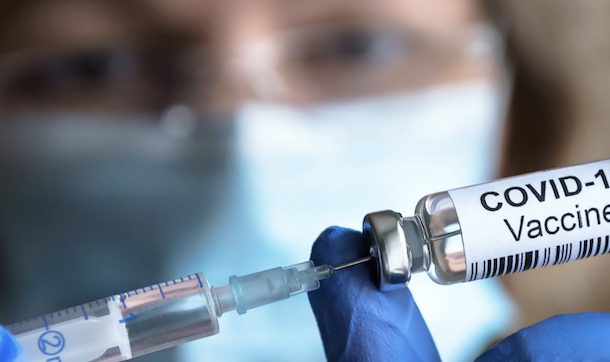
Guidance Clarifies Outbreak Period Rules for COBRA
November 8, 2021
2022 Cost of Living Adjustments
November 19, 2021On November 5, 2021, the Occupational Safety and Health Administration (OSHA) published its long-awaited Emergency Temporary Standard (ETS), which requires most U.S. employers with 100 or more employees to adopt a mandatory COVID-19 vaccination policy with an option to include an alternative weekly testing program. The ETS is effective immediately and employers must begin their compliance efforts at once. Employers have until December 5, 2021, to comply with all of the requirements of the ETS, except for the weekly testing option for employees who have not been fully vaccinated.
OSHA’s Emergency Temporary Standard: Guidance on Mandatory COVID-19 Vaccination/Testing
Employers have until January 4, 2022 to comply with the weekly testing option, though employers may begin complying earlier. OSHA anticipates the ETS will be in effect for six months from the date of publication in the Federal Register.
It is important to note that OSHA is seeking comments from the public on the ETS, and there is a possibility that the requirements may be expanded beyond their current parameters. In addition, multiple state attorneys general have filed lawsuits challenging the ETS. On November 6, 2021, a federal appellate court issued a temporary stay on enforcement of the ETS. The outcome of these legal challenge is unknown. If the ETS survives legal challenge, its current provisions provide employers with a detailed roadmap of what compliance should look like. Notwithstanding the legal uncertainty, employers should take steps to prepare for
compliance and monitor developments out of the courts.
Below you will find a summary of the important aspects of the ETS. The summary is not exhaustive and is not a substitute for legal advice.
Covered Employers
Private Sector – Private employers with 100 or more employees at any time during the effective period of the ETS, which begins on November 5, 2021, must comply.
Employers must continue to comply for the entire duration of the ETS even if their employee count drops below 100. Though employers with fewer than 100 employees on November 5, 2021 are not subject to the ETS, if their headcount reaches 100 employees at any time while the ETS is in effect, the employer must promptly comply. It should be noted that private employers with fewer than 100 employees may be required to comply if a state OSHA
program requires compliance.
“Employees” include all employees on an employer’s payroll including, but not limited to, temporary employees, part-time employees, remote employees and seasonal employees. Independent contractors are not counted as employees. Staffing agency employees are considered employees of the staffing agency and should be included in the staffing agency’s
headcount.
State and Local Governments – State and local governmental employers with 100 or more employees in states that have state-approved OSHA programs must comply. State and local governmental employers are not typically covered by federal OSHA requirements; however, in order for a state to receive approval to adopt its own State Plan, it must extend federal
OSHA requirements to state and local governmental employers. State Plans must fully adopt the ETS by December 5, 2021; thus, their compliance date will be later than November 5, 2021. While State Plans must adopt programs that are “at least as effective as federal OSHA’s requirements,” states can adopt programs that are more expansive or stringent
than the federal requirements. Thus, it is possible that some states may lower the compliance obligation below the 100-employee threshold.
Federal Government – The ETS does not apply to employees of federal agencies, except for those employed by the U.S. Postal Service.
States Prohibiting Mandatory Vaccinations, Testing or Face Coverings
OSHA intends for the ETS to preempt or override any attempts by states or localities to prevent vaccination or mask mandates and intends to invalidate any State or local requirements that ban or limit an employer’s authority to require vaccinations, face coverings or testing.
Exempt Employees
Employees who work exclusively from home, who work exclusively outdoors, or who come into the workplace only when other employees (or customers) are not present are not covered by the ETS. However, if any such worker will be entering a covered workplace during times when other employees (or customers) are present, they must either be vaccinated or be
able to present a negative test result obtained within seven days of entering the workplace.
Employees with medical conditions or sincerely held religious beliefs that prevent them from being vaccinated, undergoing weekly testing, and/or wearing a mask may be entitled to accommodations under Title VII of the Civil Rights Act or the Americans with Disabilities Act.
It is important to note that employees who have previously been diagnosed with COVID-19 are not exempt from compliance and must either be fully vaccinated or submit to weekly testing.
Full Vaccination
Employees are considered to be “fully vaccinated” two weeks after receiving a single Johnson & Johnson vaccine, or two weeks after receiving the second does of a two-dose vaccine series (i.e., Pfizer or Moderna). The ETS does not include booster shots and additional doses in the definition of fully vaccinated. The ETS provides a limited exception: employees
who have completed the entire primary vaccination series by January 4, 2022 do not have to be tested even if they have not completed the two-week waiting period.
Testing
Employees who are not fully vaccinated must comply with the weekly testing requirements of the ETS. This includes unvaccinated employees, partially vaccinated employees and employees who are exempt from vaccination due to religious or disability-based restrictions. A COVID-19 test under the ETS is a test that is:
• cleared, approved or authorized, including in an Emergency Use Authorization (EUA), by the U.S. Food and Drug Administration (FDA) to detect current infection with the SARS-CoV-2 virus (e.g., a viral test);
• administered in accordance with the authorized instructions; and
• not both self-administered and self-read unless observed by the employer or an authorized telehealth proctor.
Employees who fail to provide a weekly test result must be removed from the workplace until they can provide a negative test result.
Employers are not required to offer a testing option under the ETS. The ETS provides that employers that choose to adopt a mandatory vaccination-only policy may suspend or terminate employees who refuse to get vaccinated, unless their refusal is due to a medical condition or sincerely held religious belief that prevents them from being vaccinated, in which
case reasonable Accommodations may have to be considered. It is also important to note that the ETS does not require employers to pay for any costs associated with testing, although employers can choose to do so. Individual state or local laws may influence whether employers must cover the costs of testing. Group health plans are not required to cover COVID-19 testing for the purpose of the ETS.
Mask Requirements
Fully vaccinated employees are not required to wear masks. Any employee who is not fully vaccinated must wear a mask while in the workplace and when occupying a vehicle with another person for work purposes except:
• when the employee is alone in a room with floor to ceiling walls and a closed door.
• for a limited time while they are eating or drinking at the workplace, or for identification purposes in compliance with safety and security requirements.
• when the employee is wearing a respirator or facemask.
• where the employer can show that the use of face coverings in infeasible or creates a greater hazard that would excuse compliance (e.g., when it is important to see the employee’s mouth for reasons related to their job duties, when the work require the use of the employee’s uncovered mouth, or when the use of a face covering presents a risk of serious injury or death to the employee)
The ETS provides that a “face covering” means a covering that:
• completely covers the nose and mouth;
• is made with two or more layers of a breathable fabric that is tightly woven (i.e., fabrics that do not let light pass through when held up to a light source);
• is secured to the head with ties, ear loops or elastic bands that go behind the head. If gaiters are worn, they should have two layers of fabric or be folded to make two layers;
• fits snugly over the nose, mouth and chin with no large gaps on the outside of the face; and
• is a solid piece of material without slits, exhalation valves, visible holes, puncture or other openings.
Employer Support for Vaccination
Employers are required to provide employees with up to four hours of paid time off (PTO) from work for each required dose for a primary vaccination. Booster shots are not considered part of the primary vaccination series. Employees cannot be required to use sick, vacation or PTO time to cover these four hours Employers are required to provide “reasonable time and paid sick leave” to employees who suffer side effects from receiving a vaccination and need time off to recover. Employees may use available PTO or paid sick time to cover these
absences, but if employees don’t have enough accrued time to cover their absence, employers will have to pay for the remaining time off, and cannot advance PTO or sick leave which would result in the employee having a negative balance.
The ETS does not require employers to provide PTO in connection with weekly testing, positive test results or quarantining or isolation. It should be noted that state or local laws may impose pay obligations under some of these scenarios.
Information to Provide to Employees
Employers must inform employees, in a language and at a literacy level the employee understands, about the key components of their compliance plan including, but not limited to:
• requirements for COVID-19 vaccination
• applicable exclusions from the written policy (e.g., reasonable accommodations for workers with disabilities or sincerely held religious beliefs)
• information on determining an employee’s vaccination status and how this information will be collected
• paid time and sick leave for vaccination purposes and recovery from side effects
• employee obligations to provide prompt notification of positive COVID-19 tests and the employer’s removal practices when notified of a positive test result of COVID-19-positive employees from the workplace
• testing and masking requirements
• disciplinary consequences for employees who do not abide by the policy
• vaccine efficacy, safety and the benefits of being vaccinated (by providing the Centers for Disease Control and Prevention (CDC) document “Key Things to Know About COVID-19 Vaccines”)
• protections against retaliation and discrimination
• OSHA’s prohibitions that impose criminal penalties for knowingly supplying false statements or documentation
Recordkeeping Requirements
Employers are required to keep a list of employee vaccination status that clearly indicates for each employee whether they are:
• fully vaccinated
• partially vaccinated
• not fully vaccinated because of a medical or religious accommodation
• not fully vaccinated because they have not provided acceptable proof of their vaccination status (includes employees who have chosen not to get vaccinated and have opted for weekly testing instead)
The following documents are considered acceptable for proof of vaccination:
• the record immunization from a healthcare provider or pharmacy
• a copy of the U.S. COVID-19 Vaccination Record Card
• a copy of medical records documenting the vaccination
• a copy of immunization records from a public health, state, or tribal immunization information system
• a copy of any other official documentation that contains the type of vaccine administered, date(s) of administration, and the name of the healthcare professional(s) or clinic site(s) administering the vaccine(s).
Employers who have adopted a weekly testing option must maintain a record of each weekly test result for every employee subject to testing for the duration of the ETS. Test results are considered medical records under both the ETS and the Americans with Disabilities Act.
Employers must provide employees access to and copies of their individual test records upon request. In addition, upon request, employers must provide employees or employee representatives (such as union representatives) with the aggregate number of fully vaccinated employees at the workplace by the end of the next business day after the request.
There is no limit on the number of times these requests can be made. Employers are also required to respond to requests from OSHA for certain records.
Positive Test of Employee/Close Contact with Positive Case
An employee who has tested positive must immediately be removed from the workplace until they either:
• receive a negative result on a COVID-19 NAAT test following a positive result on a COVID-19 antigen test (NAAT tests are less likely to provide false positives);
• meet the return-to-work criteria in the CDC’s isolation guidance; or
• receive a recommendation to return to work from a licensed healthcare provide
Employees who have tested positive for COVID-19 and returned to the workplace should be not subjected to weekly testing for 90 days following the date of their positive test.
The ETS does not require employees who have been exposed to someone diagnosed with COVID-19 to be quarantined;
however, the CDC continues to recommend that unvaccinated employees be quarantined after close, prolonged contact with a COVID-positive person, and OSHA encourages employers to consider a quarantine protocol.
Employers are not required to contact trace under the ETS; however, the CDC continues to recommend contact tracing. Some state/local laws may also require contact tracing.
Employers must report each work-related COVID-19 fatality to OSHA within eight hours of learning of the fatality and each work-related COVID-19 in-patient hospitalization within 24 hours. OSHA has prepared a fact sheet explaining these reporting requirements.
Penalties
Employers that do not timely comply with the ETS may face penalties of $13,653 per violation for 2021 (2022 amounts not yet available). Willful or repeated violations can result in penalties of $136,532 per violation. States that operate their own OSHA plans must adopt maximum penalty levels that are at least as effective as federal OSHA.
Employer Action
Employers should prepare to comply and monitor developments out of the courts. If the ETS survives legal challenge, covered employers must have the following in place by December 5, 2021:
• establish a vaccination policy. OSHA has a sample mandatory vaccination policy and a sample vaccination or testing/ face covering policy which may be found at https://www.osha.gov/coronavirus/ets2
• determine vaccination status of each employee, obtain acceptable proof of vaccination and maintain records and a roster of vaccination status
• provide support for employee vaccination
• require employees to promptly provide notice of positive COVID-19 test or COVID-19 diagnosis
• ensure employees who are not fully vaccinated wear face coverings when indoors or when occupying a vehicle with another person for work purposes
• provide each employee information about the ETS; workplace policies and procedures; vaccination efficacy, safety and benefits; protections against retaliation and discrimination; and laws that provide for criminal penalties for knowingly supplying false documentation
• report work-related COVID-19 fatalities to OSHA within eight hours and work-related COVID-19 in-patient hospitalizations within 24 hours
• make certain records available
By January 2, 2022, employers must ensure employees who are not fully vaccinated are tested for COVID-19 at least weekly (if in the workplace at least once per week) or within seven days before returning to work (if away from the workplace for a week or longer). If the proposed legislation is enacted into law in its current form, the following provisions
would have notable impacts on employer-sponsored health and welfare benefit programs.
Mark J Goldstein / Goldmark Benefits / 610-674-0990 / service@goldmarkbenefits.com





